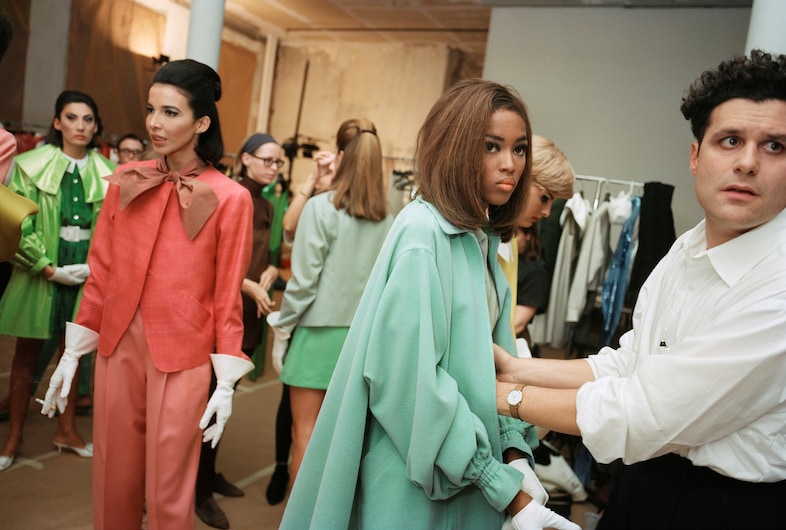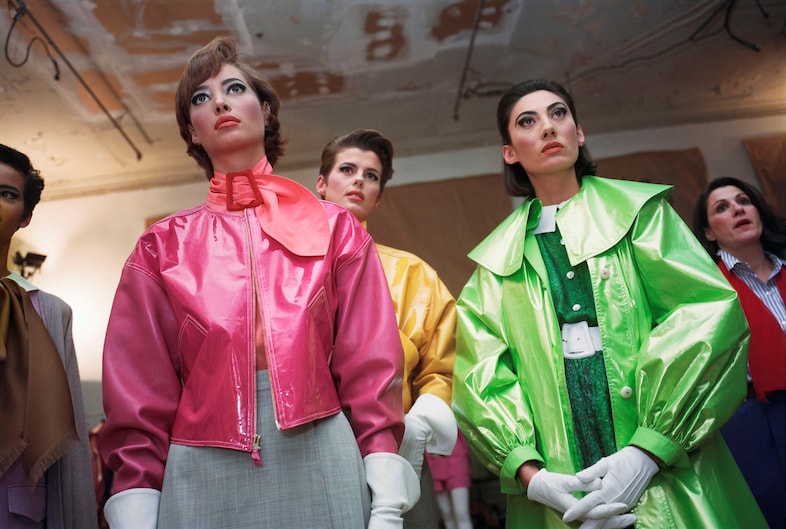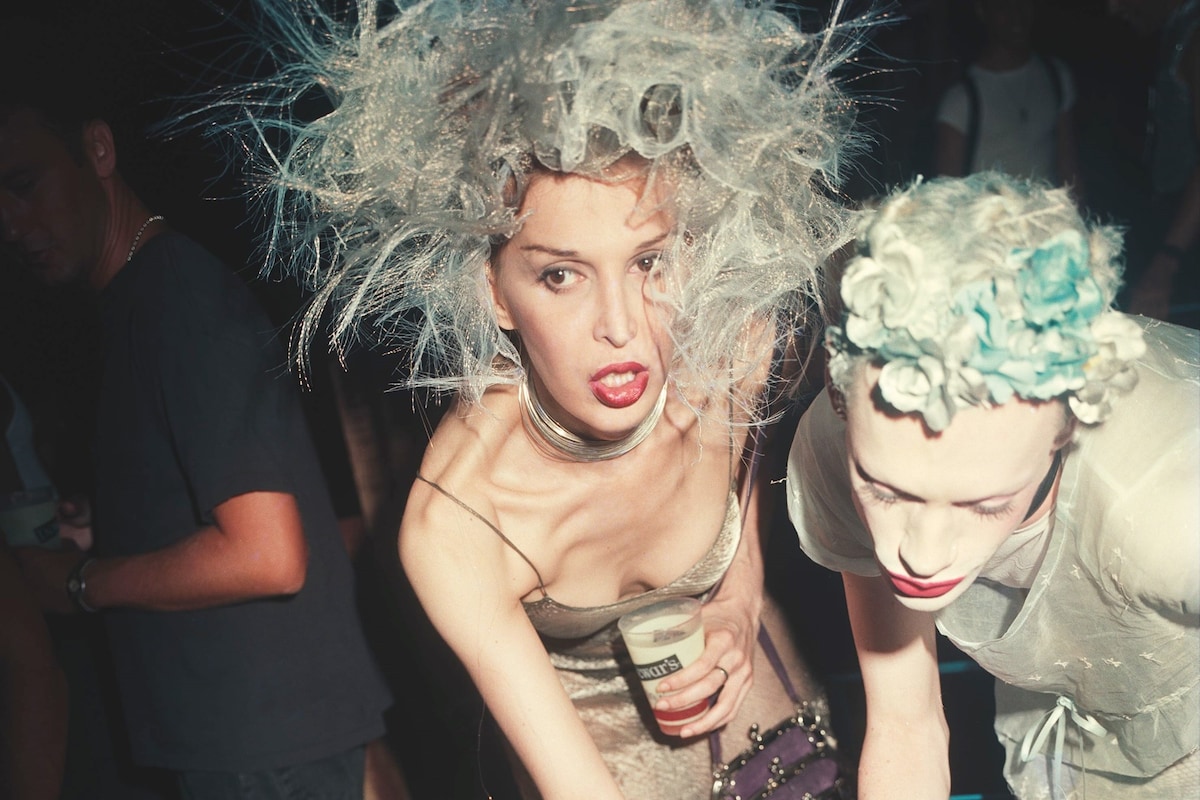Nick Waplington, We Dance in Mysteries14 Images
Nick Waplington first encountered fashion designer Isaac Mizrahi in the autumn of 1989, introduced by the photographer Richard Avedon. This initial meeting turned into a three-year relationship that spanned both the professional and the personal, resulting in a series of photos documenting the behind-the-scenes of Mizrahi’s studio in downtown Manhattan, then riotously animated with the electricity of New York’s infamous club scene. This photo series will now be showcased retrospectively in an exhibition titled We Dance in Mysteries: The Isaac Mizrahi Photographs at Hamiltons Gallery in Mayfair (opening from 27 June 2025).
Waplington, who studied at the Royal College of Art, met Avedon through a bold twist of fate. “I went for my interview at the college and they told me that Richard Avedon was coming to give a lecture as he was receiving an honorary doctorate,” Waplington tells Dazed. “I asked if I could come to the lecture – if I got in. A while later, I got a call. They told me I’d been accepted and invited me to come to the Avedon lecture and to bring my work with me. I went and took a bunch of prints, which I showed to Avedon. When he looked at them, he said, ‘whoever took these pictures has found his eyes.’”
That summer, Waplington was living in Hartford, Connecticut. Avedon phoned to ask him if he could buy some pictures. Waplington travelled to Avedon’s studio on East 77th street, “just an hour on the Metro North into the city”. This was the beginning of the friendship that soon led to his introduction to Mizrahi.
 Nick Wapplington, We Dance in Mysteries: The Isaac Mizrahi PhotographsPhotography Nick Wapplington
Nick Wapplington, We Dance in Mysteries: The Isaac Mizrahi PhotographsPhotography Nick Wapplington
Waplington’s photos invite us to taste the intensity of a now-vanished world. By day, Waplington documented the creativity and chaos of Mizrahi’s Wooster Street studio, photographing everyone who came through – Christy Turlington, Naomi Campbell, Veronica Webb – and everything that went on. As night fell, he turned his lens to the beating baseline of the city’s house and techno music culture at institutions like The Sound Factory and Save the Robots. “These clubs were spaces where time was suspended, boundaries were porous and evolving, and music was everything,” reads the exhibition’s press release.
When these photographs were taken, life was simpler, people didn’t work as much, people were having a lot of fun – Nick Waplington
Waplington caught the attention of the world with his 1990 series, Living Room, a collection portraying frank representations of people and their socio-political backgrounds. First exhibited at Aperture, the show was a huge hit. Living Room has since been shown at galleries worldwide, including Hamiltons in 2024. “Aperture wasn’t a commercial space so there was no kind of commercial viability for the work, but people were interested in it. I never expected to sell anything. I also expected at this stage in my life now to have a job and take pictures at the weekend,” he recalls fondly. “I remember being in New York City when the book of Living Room was published and I got picked up in a limo by Andre Leon Talley. We were going clubbing to see Sandra Bernhard perform. I remember that we sat looking at the book for nearly an hour in the back of the limo. Andre was mesmerised by it.” The late great Vogue editor is seen in Waplington’s photos.
 Nick Wapplington, We Dance in Mysteries: The Isaac Mizrahi PhotographsPhotography Nick Wapplington
Nick Wapplington, We Dance in Mysteries: The Isaac Mizrahi PhotographsPhotography Nick Wapplington
Waplington specifies that these aren’t documentary photographs. “I know the people I photograph, they’re people I hang out with. Sometimes they’re voyeuristic to a certain degree, as I’m often in very intimate situations with the subject matter, but I don’t have a problem with that. I’m not someone who goes out looking for things to photograph; I’m just photographing things that are around me. Whether that’s people on the council estate where my grandad lived or in nightclubs… or wherever.”
Is this series a time capsule? A love letter? Or is it something else entirely? “I don’t want to be a ‘the past is always better’ kind of person… [these photographs are from] a different time, but it doesn’t feel long enough ago that it’s the past, somehow. The music now is very similar, as are the clothes. In my opinion, the biggest difference is surveillance, everything is recorded and available somehow, which wasn’t the case back then.”
Waplington continues: “Due to tech companies, everything is tracked, and life has become more complex now. When these photographs were taken, life was simpler, people didn’t work as much, people were having a lot of fun. Things seem to be very serious now, there definitely used to be a lackadaisical approach to life, people weren’t looking for a big career or payday… people could survive on less.”
We Dance in Mysteries: The Isaac Mizrahi Photographs will show at Hamiltons Gallery from June 27th until September 23rd. Waplington continues to work in London and New York on a series of photographic and mixed medium projects.
